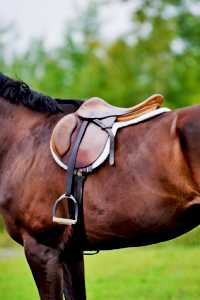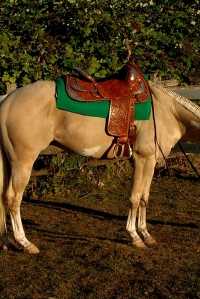|
By Jerry Tardif
A sliding saddle problem is not uncommon, especially with any breed that tends to have a round-barrel chest, such as Quarter Horses do.
Even saddles on horses that are thinner on the sides than they are high will still slide around when the horse has been sweating from a ride on a warm day.
And because sweat contains fleshy oils, it's much slipperier than wetness from rain.
Still, perspiration is not generally the whole problem.
The cause is usually a combination of things.
For example, the saddle can be loose, poor fitting, not placed correctly, using a saturated saddle pad or blanket, or some combination of the above.
There is no "one fix".
You can't stop your horse from sweating, but you can correct each of the other problems.
First, let's cover best practices for saddling a horse whether English or Western:

English Saddle
|

Western Saddle
|
The saddle you use should be properly sized for your horse.
If it's not the right size for him, you're looking for all kinds of problems that will usually result with a hurt horse and an unstable saddle.
A saddle of the right size and correctly shaped tree for your horse is paramount for his comfort and his safety (and therefore, your safety as well).
Make sure to use a saddle pad, blanket, or numnah to absorb sweat and help distribute load on your horse's back.
It will also provide some shock absorption while trotting and jumping.
Assure the pad is clean, especially the underside touching the horse.
I once saw a man placing a pad on his horse that had burrs and other debris and he made no effort to remove them until I embarrassed him.
Start by placing your saddle in the correct location — that's just behind the withers.
Many people place their saddle too far back and that can cause many problems.
First, the saddle tree is not designed for the saddle to be there.
Second, being further back can hurt and permanently damage your horse's spine.
Third, we riders are supposed to be positioned over the horse's center of gravity.
Putting the saddle further back will upset your horse's balance, especially at the faster gaits, or even worse: when jumping.
BUT, make sure the gullet of your saddle is deep enough that it doesn't touch your horse's withers.
The pommel should be over the rear slope of his withers and not touching it.
Don't try to tighten the girth all at once; do it in stages.
Doing so allows your horse to adjust to being compressed a little from the girth.
It also deals with the problem of those horses that like to inflate their lungs to keep the girth loose.
When you tighten, don't jerk it tight — that can startle your horse and hurt him.
Instead, pull it slowly tighter so your horse can adapt to it as you go.
As long as you're leaving room for a couple of fingers under the buckle, you shouldn't be too tight.
If you tighten a lot more, you can hurt your horse and the saddle will still slip when he perspires, so, tightening alone is not the answer.
In the first few minutes of riding, move into a slow trot and then back to a walk.
Do this several times, then, recheck the girth's tightness.
Some horses that inflate their lungs to stop you from having a safely tightened girth can maintain it until they start to work.
This test will get you beyond that point to make a more accurate assessment of girth tightness.
If it's now loose, retighten to previous specifications (a little of the mechanic in me coming out).
Using a mounting block helps because it doesn't shift the saddle by you having all your weight in only one stirrup while pulling yourself up.
But it's a lot harder when you have to dismount on the trail and then remount a sweaty horse with a slippery saddle.
At those times, I check the girth to assure it's still as tight as it should be, and then I look around for a rock, stump, a fallen tree, a steep little hillside, or some other prop I can use to lift myself up high enough to just throw my leg over the saddle.
If you ever mount from the stirrup and the saddle swings around to the side, don't just rotate it back because the sliding around has pulled hair and possibly even skin.
Loosen the girth completely and then rotate the saddle and pad.
You should actually lift the front of the pad to pull it forward again and perhaps slightly ahead (e.g. an inch or so) of where it should be.
Then, let it back down and slide it back that inch to assure your horse's hair is not bent uncomfortably forward against its normal direction of fall.
If you don't do that, it can be uncomfortable for your horse.
Using one of the new sticky pads can be a good idea, but I have no experience with them.
I've known a few people that have tried them, but it didn't seem to solve the problem.
Still, it may be the solution for some riders.
Finally, developing a good, balanced seat is also important so that we riders aren't depending upon the saddle and stirrups to stay on top of our horse.
Riding is all about balance and those using their saddles and stirrups to stay on top instead being balanced puts lots of extra twisting forces on their horse's skin and spine — neither of which are good for the horse.
It's a good idea to take some lessons occasionally, if for no other reason than we all can get into bad habits and poor form.
This suggestion is even more important for those riders that are self-taught and have never received formal instruction.
The foregoing does not guarantee that your saddle won't slide around your horse if he's very rounded or wet from perspiration.
But it will reduce the chance of sliding and also the chances of injury to him from a incorrectly sized, positioned, or adjusted saddle.
Besides being an avid trail rider, Jerry Tardif is a technology consultant and a horse and nature photographer in SE Connecticut — see his work at: www.jerrytardif.com.
He is also co-founder and President of QueryHorse.
Back to Article Index
|